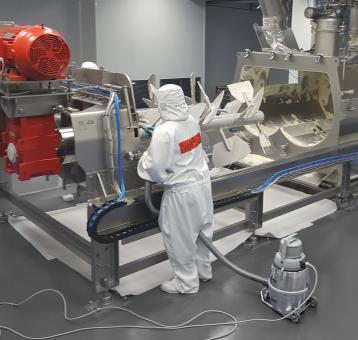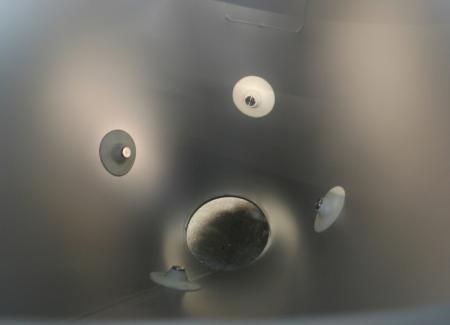This article discusses:
- Hygienic design criteria for machines using dry substances
- The properties of dry matter
- The different ways to clean machines after processing dry materials
- Construction materials in the equipment that handle it hygienically
The experts at Dinnissen Process Technology are available to answer all your questions:
Get in touch with Juul Jenneskens 077 467 3555
Hygienic design criteria for machines that handle dry substances
Every material that is processed in the food industry requires specific safety requirements. This also applies to dry substances. The machines must meet various hygienic design criteria. Equipment commonly used in dry solids handling include grinders, mixers, strainers, powder valves, dryers, dosing systems, storage containers, silos, agglomerates and granulators. All these equipment must be able to clean them so that the dry food product does not become contaminated. When powders, such as agglomerates and granular materials, are processed, there is a risk of agglutination. There is also the risk of product deposits and microbial growth with too high a moisture content. This should be taken into account in the equipment design process. In addition, there is the risk of dust formation. When too much dust is formed during processing, the risk of dust explosions increases. This must also be taken into account in the design phase. The final design of the machine mainly depends on the way of cleaning and the moisture content of the dry material.
The properties of dry matter
In general, powders are defined as individual particles less than 150 μm in diameter. This diameter may differ depending on the type of powder. For example, the ultra-fine particles, such as anti-caking agents, have an average diameter of 10 μm. The agglomerates and granulates, such as with soup and coffee, can have a diameter of a few millimeters. Dry substances can therefore be quite different from each other. An exact definition of microbial stability is therefore difficult to formulate. The following rule of thumb is used in industry: if the water activity is below 60%, little to no microbial growth will occur. A comprehensive definition of dust particles is difficult to formulate. Dust particles can be characterized on the basis of the properties of the individual particles and on the basis of the bulk properties. Bulk properties indicate how the substance behaves in the total fabric mass, such as abrasion resistance, bulk density, flow properties, particle size distribution and dustiness. On the other hand, properties of the particles individually indicate how a dust particle behaves individually. Typical properties of the individual particles are: density, hardness, moisture content, shape and tack. Both types of properties are important and vary from fabric to fabric, which means that the processing time of a fabric also varies.
An important bulk property of powder is its flow behavior. When powder does not flow properly, a part can remain in the machine. This is not good for hygiene. This flow property can be improved in a number of ways:
- Reduce moisture content, resulting in less stickiness,
- reduce the amount of fine dust,
- reduce the neutralization of surface charges,
- increase particle size and sphericity.
The different ways to clean machines after processing dry substances
When dry materials, such as powder are handled hygienically, it affects aromas, colors, flavors and chemical, physical and biological activities. Good cleaning is therefore crucial in order not to lose these desired properties. Cleaning can take place dry or wet. In addition, the cleaning procedure can take place manually, semi-automatically or fully automatically. When cleaning with water, the contact surfaces should be slightly inclined so that the cleaning agents can easily rinse away. In order to also ensure that material does not accumulate, sharp corners (radius ≤ 6mm) and cavities in the machine must be avoided as much as possible.
Dry cleaning can be applied in places where:
- one or more dust layers of the dry material remain behind and these do not pose a risk to the material that is subsequently processed in the same machine,
- any cross-contamination of residual and new material is no problem,
- the remaining material cannot provide microbial growth due to moisture and temperature,
- the dry material is not hygroscopic or tacky.
- With manual dry cleaning, the largest deposits and dust layers are removed with a vacuum cleaner. Other residues are manually swept up or scraped off with brushes or scrapers. This should not cause too much dust formation. For that reason, cleaning with compressed air is also not a good option, because it creates dust clouds that spread the dust and dirt.
Semi-automatic dry cleaning uses built-in air blowers and retractable nozzles. Air blowers blow the remaining material into a collection area, so that it can still be processed. A precondition for this is that the surfaces must not be contaminated and the air is of process quality and filtered. In addition, vacuum cleaners can also be used and hard particles such as rice or plastic balls serve as an abrasive for the pipe system.
Wet cleaning can be applied in places where:
- the dry material remaining behind poses a risk to the dry material that is subsequently processed,
- no cross-contamination between residual and new material may occur,
- the residual material can cause microbial growth due to moisture and temperature,
- the dry material is hygroscopic or has a low softening point, which can cause deposits to form and remain in the machine.
- The manual wet cleaning procedure starts with removing the deposits through a dry cleaning procedure. The contact surfaces are then soaked with water and cleaned with brushes, scrapers or water hoses. After manual cleaning, the machine must be dried immediately and thoroughly with warm air before a new product can be processed.
The semi-automatic wet cleaning method is called Washing-In-Place (WIP). Sprinklers are lowered into the pipe system or into the silos that clean the dirty surfaces with water and cleaning agents. The machine is then rinsed with water and must be dried thoroughly with warm air immediately. The cleaning fluids are collected and recirculated through the cleaning system. Separate storage tanks are used for cleaning water, cleaning agents or special liquids.
The automatic wet cleaning method is called Cleaning-In-Place (CIP). This is a fully automated cleaning procedure that does not require disassembling parts to install nozzles. These cleaning systems contain permanently mounted nozzles that are connected to the recirculation pumps and storage tanks for cleaning fluid. Afterwards, the equipment is immediately automatically dried with warm air.
Hygiene is paramount when cleaning the machines, but safety should not be forgotten either. Some cleaning methods, such as manual wet and dry cleaning, sometimes require the machines to be taken apart. This must be done in a safe manner. No special tools or hoists should be required for this. In addition, the cleaning equipment may not be used on other materials or for other purposes. The cleaning equipment must be cleaned and maintained regularly. The equipment must be stored in a clean environment. Broken tools should not be used as they can leave broken parts in the machine and cause contamination.

Dry cleaning

Wet cleaning

CIP cleaning
The test procedure is a basic screening test to identify areas of poor hygienic design and where product or microorganisms are protected from the action of the cleaning process
Construction materials in the equipment that affect hygienic processing
The construction materials in the equipment also have an important influence in the hygienic processing of substances. The construction materials that come into contact with the food must be food-grade. This means that these materials can come into contact with the dry matter without risk. The exact construction materials that can be used depend on the dry materials, the cleaning method and the cleaning agents.
It is best to use stainless steel contact surfaces or other metals that do not corrode. Other materials can only be used under certain conditions. Aluminum and aluminum alloys are only suitable for dry cleaning. During wet cleaning, aluminum can cause corrosion problems. In addition, plastics may also be used when processing dry materials. They must have minimal contact areas when the dry material has an abrasive action. When plastics come into contact with the dry material, they must also retain their original surface properties and shape during production conditions. Choosing non-metallic surfaces can result in an electrostatic charge on the dry material. Small particles then stick to the non-metallic surface and that can cause problems, also in pneumatic conveying systems.
Regardless of what type of material is used, product surfaces must always be completely smooth so that no material can penetrate. A surface roughness of Ra ≤ 0.8 μm is recommended if there is a risk of microbial growth due to high humidity or if wet cleaning is used. Then there is no further need for cold rolled steel treatment and the roughness of the surfaces meets the general stainless steel procedures. However, the surface roughness of cast materials and carbon steel does not meet this requirement. The hygiene of parts made of this material in combination with the dry matter must therefore be investigated.
Welding surfaces must also be hygienic. No problems with corrosion and accumulation of material should arise in these places. It is important that there are no interrupted welds, because they do not meet the hygienic conditions. In addition, the metallurgical properties of the welding material must correspond as much as possible to the metal to be welded. However, in most cases welded surfaces cannot meet the standard of Ra ≤ 0.8 μm and therefore the cleanability of these parts must first be tested.

Name: Juul Jenneskens
Advisor
Please feel free to contact me if you have any questions about this subject. My team of colleagues and I are ready to answer!
Get in touch with Juul Jenneskens 077 467 3555 [email protected]
Do you prefer to request a consultation directly?
